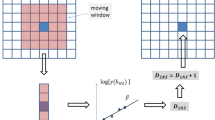Abstract
Sea-floor bathymetric profiles exhibit features at many different scales of length; this suggests that they could be described as fractals. An algorithm interpolating a fractal line between points has been used to reconstruct bathymetric profiles from a few data points. In general, this fractal line has the same Fourier amplitude spectrum as real bathymetry, and, if the parameters of the interpolation are suitably chosen, it has a very similar appearance. The success of this fractal reconstruction algorithm for the sea-floor raises the possibility that it could be used to extrapolate, from data collected at one scale, the properties of the sea-floor at finer scales, and that similar techniques could be used to interpolate a surface between bathymetric profiles. The fractal character is a sign that the processes that shape the sea-floor are scale invariant and suggests that the renormalization group technique could be used to model these processes.
Similar content being viewed by others
References
Abbott, D. (1986),A Statistical Correlation Between Ridge Crest Offsets and Spreading Rate, Geophys. Res. Lett.13, 157–160.
Allegre, C. J., Le Mouel, J. L. andProvost, A. (1982),Scaling Rules in Rock Fracture and Possible Implications for Earthquake Prediction, Nature297, 47–49.
Barenblatt, G. I., Zhivago, A. V., Neprochnov, Yu. P., andOstrovskyi, A. A. (1984),The Fractal Dimension: A Quantitative Characteristic of Ocean Bottom Relief, Oceanology24, 695–697.
Barnsley, M. F. (1987),Fractal Functions and Interpolation, Constr. Approx.2, 303–329.
Barnsley, M. F., andDemko, S. (1985),Iterated Function Systems and the Global Construction of Fractals, Proc. Roy. Soc. London Ser.A 399, 243–275.
Bell, T. H. (1975),Statistical Features of Sea-Floor Topography, Deep Sea Res.22, 883–892.
Berry, M. V., andLewis, Z. V. (1980),On the Weierstrass-Mandelbrot Fractal Function, Proc. Roy. Soc. London. Ser.A 370, 459–484.
Crough, S. T. (1987),Thermal Origin of Mid-Plate Hot Spot Swells, Geophys. J. Roy. Astr. Soc.55, 451–469.
Davis, E. E., andLister, C. R. B. (1974),Fundamentals of Ridge Crest Topography, Earth Planet. Sci. Lett.21, 405–413.
Detrick, R. S. (1986),Introduction to the Sea Floor Mapping Section, J. Geophys. Res.91, 3331–3333.
Fox, C. G., andHayes, D. E. (1985),Quantitative Methods for Analyzing the Roughness of the Sea-Floor, Rev. Geophys. Space Phys.23, 1–48.
Jarvis, G. T., andPeltier, W. R. (1980),Oceanic Bathymetry Profiles Flattened by Radiogenic Heating in a Conductive Mantle, Nature285, 649–651.
King, G. (1983),The Accommodation of Large Strains in the Upper Lithosphere of the Earth and Other Solids by Self-Similar Fault Systems: The Geometrical Origin of b-Value. Pure Appl. Geophys.121, 761–815.
Klitgord, K. D., andMammerickx, J. (1982),Northern East Pacific Rise: Magnetic Anomaly and Bathymetric Framework, J. Geophys. Res.87, 6725–6750.
Malinverno, A. (1989),A Test of the Fractal Character of Sea-Floor Topography, Pure Appl. Geophys.131, 139–155.
Mandelbrot, B. B.,The Fractal Geometry of Nature, 3rd edition (W. H. Freeman and Co., New York 1983).
Mareschal, J.-C., Barnsley, M., andHardin, D. (1985),Fractal Reconstruction of Sea-Floor Topography, EOS66, 355.
Oldenburg, D. W. (1975),A Physical Model for the Creation of the Lithosphere, Geophys. J. Roy. Astr. Soc.43, 425–451.
Parker, R., andOldenburg, D. D. (1973),Thermal Model of Ocean Ridges, Nature Phys. Sci.242, 137–139.
Parsons, B., andSclater, J. G. (1977),An Analysis of the Variation of Ocean-Floor Bathymetry and Heat Flow with Age. J. Geophys. Res.82, 803–827.
Richter, F. M., andParsons, B. (1975),On the Interaction of two Scales of Convection in the Mantle, J. Geophys. Res.80, 2529–2541.
Sandwell, D. T. (1984),Thermomechanical Evolution of Oceanic Fracture Zones, J. Geophys. Res.89, 11401–11413.
Sandwell, D. T., andSchubert, G. (1982),Lithosphere Flexure at Fracture Zones, J. Geophys. Res.87, 4657–4667.
Smalley, R. F. Jr., Turcotte, D. L., andSolla, S. A. (1985),A Renormalization Group Approach to the Stick Slip Behavior of Faults, J. Geophys. Res.90, 1894–1900.
Turcotte, D. L. (1986),Fractals and Fragmentation, J. Geophys. Res.91, 1921–1926.
Tolstoy, I.,Wave Propagation (McGraw Hill, New York 1973).
Wilson, K. G., andKogut, J. (1974),The Renormalization Group and the ε Expansion, Phys. Rev. C.12, 75–200.
Author information
Authors and Affiliations
Rights and permissions
About this article
Cite this article
Mareschal, JC. Fractal reconstruction of sea-floor topography. PAGEOPH 131, 197–210 (1989). https://doi.org/10.1007/BF00874487
Received:
Revised:
Accepted:
Issue Date:
DOI: https://doi.org/10.1007/BF00874487




